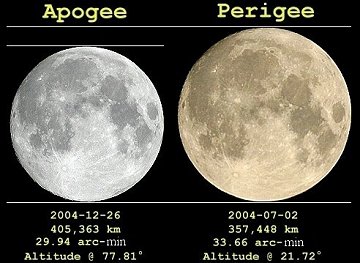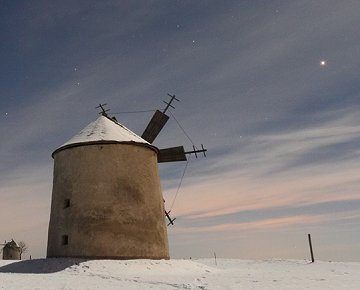SATELLITE FLYBYS APP: Turn your iPhone or iPod into a field-tested satellite tracker! Spaceweather.com presents the Satellite Flybys app. | | | STRATOSPHERIC CLOUD ALERT: On the evening of Jan. 26th, sky watchers in parts of England and the Netherlands witnessed unusually colorful sunsets and prolonged twilights. Atmospheric optics expert Les Cowley believes that "we are experiencing an episode of Polar Stratospheric Clouds (Type 1) as a result of unusually low stratospheric temperatures. I saw them myself." High-latitude sky watchers should be alert for these clouds at sunrise and sunset in the days ahead. Images: #1, #2, #3, #4. BIGGEST FULL MOON OF THE YEAR: This Friday night, if you think the Moon looks unusually big, you're right. It's the biggest full Moon of 2010. Astronomers call it a "perigee Moon," some 14% wider and 30% brighter than lesser full Moons of the year. (continued below) 
Image credit and copyright: Anthony Ayiomamitis: details.
Johannes Kepler explained the phenomenon 400 years ago. The Moon's orbit around Earth is not a circle; it is an ellipse, with one side 50,000 km closer to Earth than the other. Astronomers call the point of closest approach "perigee," and that is where the Moon will be Friday night: diagram. Look around sunset when the Moon is near the eastern horizon. At that time, illusion mixes with reality to produce a truly stunning view. For reasons not fully understood by psychologists, low-hanging Moons look unnaturally large when they beam through foreground objects such as buildings and trees. Why not let the "Moon illusion" amplify a full Moon that's extra-big to begin with? The swollen orb rising in the east may seem close enough to touch. And what's that bright orange star right beside the Moon? Read on... IT'S MARS! In a coincidence of celestial proportions, the Moon and Mars are having close encounters with Earth at the same time. Moreover, the two will spend Friday night gliding across the sky side-by-side. It's a must-see event: sky map. On Jan. 27th, Tamas Ladanyi of Tes, Hungary, caught this view of the Red Planet, pre-conjunction: 
"I used a Canon 500D (ISO 1600, 6 sec) to photograph the winter landscape on the plateau of Tes with its famous windmills in bright moonlight," says Ladanyi. "Mars shone beautifully above it all." Readers with backyard telescopes should train their optics on Mars. The planet looks bigger through a telescope now than at any time between 2008 and 2014. Browse the links for views through the eyepiece: from John Nassr of Baguio, Philippines; from Alan Friedman of Buffalo, New York; from Mike Hood of Kathleen, Georgia; from John Nassr of Baguio, Philippines; from Jacob Bassøe of Copenhegen, Denmark; from Sadegh Ghomizadeh of Tehran, Iran;
January Northern Lights Gallery
[previous Januarys: 2009, 2008, 2007, 2005, 2004, 2001] | 
